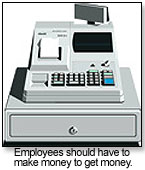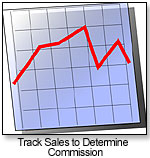 |

Tools:








How to Create a Commission Structure That MotivatesSetting Goals for Individuals and the Store Keeps Everyone Playing Fair
The following article was reprinted with permission from the author.
Sandy, a Retail Doc Fan page follower sent me this message: “I’m looking to change our commission structure. Currently we pay 3% of each sale. Considering doing it off of store profit. Any suggestions would be helpful.”
First I have to say I believe in commissioning sales. Whether that means employees get an hourly rate and a % of sales they make like Sandy, a bonus at the end of the month or a chance to win at trip. Call it what you want but the best bosses share the wealth, not hoard it.
 Why Flat Commissions Don't Work Why Flat Commissions Don't Work
That said, paying a flat commission on everything means it is a given, there are no goals to have to achieve so it can lead to employees feeling they are “entitled” to it rather than having to earn it.
Some stores only commission high-profit items or various levels to minimize paying commissions on staples or low-margin, high sale items.
I’m sharing what admittedly could seem complicated but read all the way through. I have found it to be fair and easily understood by employees.
The ultimate goal is to come up with a store goal that is reasonable (see my book, "The Retail Doctor's Guide to Growing Your Sales") then reward those who go “above and beyond to achieve it.” Here’s how:
1. Make a schedule for the month. Don’t just say for example, John works 120 hours if he doesn’t work weekends and there are five. Enter each employee, each shift’s total hours to the best of your abilities.
2. Total up each employee’s hours for the month.
3. Add all employees total hours, then multiply the total hours by 15%. This is the maximum amount of hours you expect to use for the month.
4. Divide your total store goal by that figure.
5. Multiply your individual employees hours by that number to arrive at the amount every employee (who could sell some thing)’s monthly goal.
6. Then, each day your employees work, make a goal sheet with each employees name and the amount they are expected to sell that day. (Notice the italicized amounts under each employees name in the figure.)
7. At the end of the month, you use actual figures for total hours employees worked to arrive at correct dollars per hour they should have sold.
 8. If the store hit the store goal, you reward those who went over their goal by whatever you have promised whether that is a % of the increase or other bonus. If the store missed the goal, even if an employee “hit” their goal, no bonus. Its great to have superstars but you need the crew to hit the goal in order to share in the increased business. Otherwise you just end up paying certain employees more because they clerk more or hog the floor from the others – neither of which builds sales. 8. If the store hit the store goal, you reward those who went over their goal by whatever you have promised whether that is a % of the increase or other bonus. If the store missed the goal, even if an employee “hit” their goal, no bonus. Its great to have superstars but you need the crew to hit the goal in order to share in the increased business. Otherwise you just end up paying certain employees more because they clerk more or hog the floor from the others – neither of which builds sales.
Here are two thing that make this valuable:
- Nothing happens unless they hit the goal and
- You only pay out based on actuals, but set the bar higher in case someone quits and you need to train someone new.
Those who consistently hit goal deserve to stay; those who consistently miss don’t. Even if it’s your son or significant other!
Again, a key is to not include hours for stock people who have no ability to sell anything.
Keep Employees Invested
Yes, you’ll get some employees who’ll say it isn’t fair they work “nights” or “mornings” while others work limited hours on weekends. They can only move the needle of sales if they are in the store at least 3 days a week. To help minimize this, don’t allow part-timers to only work 10 hours a week. Otherwise, your business is a distraction, not a destination for their attention. Make sense?
Finally, whatever you do to reward employees’ sales, pay it out as quickly as possible to keep them motivated, preferably within a day or two of the end of the month. Using this commission system isn’t the only way to produce sales but it clearly sets boundaries for your crew to move the needle higher.
 Writer's Bio: Writer's Bio: Bob Phibbs is the Retail Doctor®, a best-selling author and speaker who has helped thousands of independent businesses compete. His new book, The Retail Doctor’s Guide to Growing Your Business has received praise from both Inc. magazine and USA Today and can be found at your local bookstore or ordered at http://www.retaildoc.com/guide. He and his work have been featured in the New York Times, the Wall Street Journal and Entrepreneur magazine. Questions? Contact Bob at info@retaildoc.com. This article was reprinted with permission of the author, Bob Phibbs, aka The Retail Doctor®. Read more articles by this author
THIS BANNER IS AN AD:

• • • • • • • • • • • • • | • • • • • • • • • • • • |
Back to TDmonthly's front page
|  |
Advertise on TDmonthly

|

